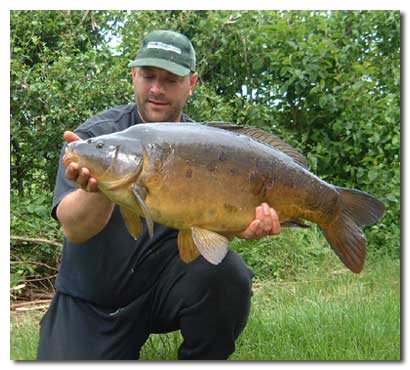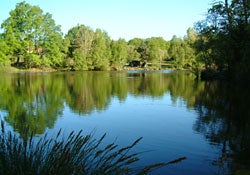| BIG RIK (CARP ANGLER) | |
Rik started fishing at the age of four on his local tiny tidal river, catching eels and small wild trout on worm. Not having had any angling family members, all his early fishing was solitary and this seems to have carried through to the present. Like most anglers nowadays, he has a full time job and a family, so his fishing time is limited, although he does, he tells us, have a very understanding wife.He currently lives in the depths of Hampshire, and so is within easy reach of some excellent venues. He has in the past, and still does, fish for most species, although his greatest love is for carp fishing, which is how the majority of his time is spent. He now finds himself more thrilled with overcoming the intricacies and problems associated with catching carp, rather than the actual weight of the fish he catches and the so-called glory that goes with it. |
A BEGINNERS QUESTIONS
Having again just recently fished with a different beginner/learner, I could tell that he was just itching to ask me loads of questions, so I let him fire away until he had confused himself.
The reason he was so confused was that my answers to his rig questions and my rigs were the same as his.
My bait was no different. My PVA was just the same, etc, etc.
  |
“You want to know what THE secret is don’t you?”
His eyes lit up and a grin spread across his face. “Yes please!”
“There isn’t a big secret, it’s all down to hard graft and experience.” I told him.
The disappointment etched across his face was sorrowful. I left him rummaging through my rig bin, tackle box and bait bucket. Sure, we had different things, but they were much of a muchness. Same product, different manufacturer.
After his fruitless search had ended, I told him that there were only two things I had that were any different to his.
My eyes and my experience.
My eyes showed me things as we walked around the lake that didn’t register with him. He had already shown a liking for a reedy corner swim and although under other circumstances this may have been my choice of swim, the facts were against it.
The wind, although not particularly strong, was blowing into a different area of the lake, and, more importantly for me, the swim next door, a small point, was already occupied by someone who had two rods fishing at a reasonable distance and with tightish lines.
This effectively cuts off the corner swim and may prevent carp from entering the bay because they may be wary of swimming under taught lines.
I’ve noticed with people before, and they are usually beginners to carping, that they need a visible feature to fish to. If there are no islands to fish against, then the corner swim is chosen, as it usually offers reedy margins or overhanging trees and bushes. In short, a physical feature to aim at.
Time, and confidence in your own ability, will mean that you will learn to fish to less visible features and these will probably provide you with more fish, which in turn will boost your confidence in them and an upward spiral will start.
On our wander around the lake we came across the corner that the wind was blowing into and although this looked good with the built-up surface scum, the breeze was quite gentle and had been blowing in that direction for several days.
The other point to note about corner swims is their topography
Do they have deep or shallow, shelving margins?
A marginal depth of three or four feet, or deeper, with overhanging bushes or trees is more likely to draw and hold carp than a shallower more barren corner.This may sound very obvious, but the depth can be difficult to ascertain if there is a large scum build-up on the surface.
Again you will need to take into account whether adjacent swims are occupied and where other people’s lines are pointing.
  |
This also gives you some leeway for a little bankside noise, not necessarily created by you, but possibly by visiting guests and bailiffs. What you do not really want is a good intentioned angler, asking after your fortunes, but standing on your marginal spot.
This is also a two way thing. When approaching other anglers, keep off the skyline, keep the noise down and the footfalls light. There’s no point in upsetting anyone unnecessarily, especially if you’re after a bit of info. Show some courtesy and respect and they’ll hopefully be more receptive and open to your questions.
As we continued around the lake I spotted a fish show at about fifty yards from the bank. There was an area with weed to the surface and an apparently clear area in front of it. The fish gave away it’s location by creating a flat spot in the gently rippling surface. The show was in amongst the weed, so it was very unlikely to be a bream as they tend to show themselves and feed in clearer areas, and as tench are virtually non-existent, I concluded that it was probably a carp.
I explained this as I tried to point out the flat spot, all to no avail.
We sat in the swim scanning the surface for any movement and five minutes later we were rewarded with another show. A further ten minutes with no more movements and we continued on our walk around the lake. By the time we had got back to our starting swim, we had not seen any further evidence of any carp, so I talked him in to trying out the swim we had seen the carp show in.
When we got to the swim, I suggested that as there wasn’t loads of fish showing, then it might be prudent to have a lead-about with the marker rod, so we could ascertain the type of bottom he would be fishing over and to note down the edges of the thickest weed and attempt to find any clearer patches.
Some points to remember when leading-about or using a marker rod
- Pull the rod tip back parallel with the water, smoothly and slowly
- When you feel something of interest let the float pop to the surface so you can visually locate the feature
- Keep pulling the lead through to attempt to determine the size of the feature Cast either side of where you raised your marker to determine the width of the feature
- If the features are small and difficult to locate, then put the line into the reel clip so you can hit the spot again
- Pick a far bank marker for accuracy
- If you’re going to fish into darkness, ensure it’s one you can spot at night
- Cast accurately
Once you have found your feature and your marker float is sat at the surface, then cast one of your rods to the marker.
I always put a hooklink on, so I can tell just how clean the spot actually is. This will then tell me how I need to present the bait and the length and style of hooklink required. If I pull in fresh, green, crispy weed, then I’m confident I’m fishing over emerging weed growth and the length of the strands will tell me how high it is. If the hook comes back empty, then I know I’m over clean gravel.
Two spots were found.
One was an area of light, three inch high, weed growth, as close to the showing fish as possible, before the weed became too thick. This area would be fished with a PVA bag of broken boilies and pellet, with a 3″ pop-up on a green Snakeskin hooklink. The second spot was a clean gravel area about fifteen feet to the right and this was fished with a standard bottom bait and a PVA stringer of freebies.
Because the spots were quite small and tight, I then advised him to clip up when casting. This was achieved by tying a power gum stop-knot (grinner) to the mainline at the required distance and then placing one of the tag ends of the knot into the line clip of the reel when casting out and this is then removed once you’ve hit the mark.
We’ve seen some fish and the spots have been found and can be hit again at any time.
Now all we had had to do was sit back and wait for the fish.











